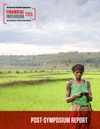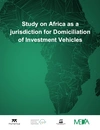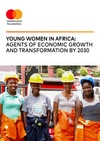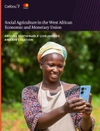Watch an introduction to some of the issues discussed at this year’s Symposium on Financial Inclusion
In Review: The 2015 Mastercard Foundation Symposium on Financial Inclusion
Dear SoFI2015 attendees,
We are pleased to share with you this report on The MasterCard Foundation Symposium on Financial Inclusion 2015, held in partnership with the Boulder Institute of Microfinance in Cape Town.
The Symposium theme of Clients at the Centre led us to dive deeper into the client experience, explore how leadership and organizational culture can contribute to delivering client value, and demonstrate how that value can contribute to the business case for service providers.
The push towards universal inclusion has reached a pivotal point – the number of people without access has fallen to two billion. The 2020 goals set by the World Bank, or the 2030 Sustainable Development Goals, will only be achieved if banks and other financial service providers adopt or strengthen customer-centric practices. There is much more work to do and it is up to us to lead change within our organizations. We need to put clients at the centre of everything we do in order to increase regular use of products and services by those living in poverty in developing countries.
We hope that those of you who attended the Symposium had the opportunity to connect and to share what you are learning. We also hope that you came away inspired and prepared to take action to effect change in your organization, enabling it to become more client-centric.
We look forward to the next Symposium and encourage you to stay in touch with us, and with each other. We hope you continue to share your ideas on how we can advance financial inclusion for the benefit of clients and their families.
Ann Miles
Director,
Financial Inclusion &
Youth Livelihoods
The MasterCard Foundation
Robert Christen
President and Founding Member,
Boulder Institute of Microfinance
Clients at the Centre
SoFI 2015: Client Centricity is...
At The MasterCard Foundation Symposium on Financial Inclusion, we asked the experts to finish the following sentence: "Client Centricity is..."
In 2015, The MasterCard Foundation Symposium on Financial Inclusion brought together more than 300 of the world’s leading financial practitioners and experts on financial inclusion in Cape Town, South Africa. Attendees shared their experiences in connecting people with financial services that improve their livelihoods and support economic development.
The Symposium was structured around three themes:
- How leaders motivate employee behaviour and internal culture to ensure their organization is focused on delivering client value.
- Key dropout points along the client journey and consideration of what stakeholders can do to improve the customer experience.
- Business-case development for client centricity for service providers.
In her welcome address, President and CEO of The MasterCard Foundation Reeta Roy said that to become truly client-centric, the sector must focus on the emotional value of financial products and services for clients.
“If we understand the lives of the people our organizations serve,” she said, “if we understand that financial services enable them to send their children to school, put food on the table, and save, we can design products that are truly relevant. And we will reach the remaining people who lack access.”
In Robert Christen’s welcome address, the President and Founding Member of the Boulder Institute of Microfinance said that if the sector doesn’t confront business challenges, it will begin to have significant problems.
“Becoming more focused on the client makes good business sense,” he said. “The future belongs to understanding the client more deeply for the first time.”
Don’t get carried away with tech for tech sake. Start with the customer and if tech is a solution then use it.
The idea of client centricity is easy, but building an organization that radically redefines its business proposition requires skills in change management.
We have leaders among us, who are using client centricity to redefine financial inclusion. Let’s take inspiration from them, and from each other.
Key Takeaways
1. Understanding the behaviour of clients is the key to increasing use of financial products and services.
The Symposium outlined how successful products and services are often those from organizations that emphasize the client experience.
Ken Njoroge and Bvolaji Akinboro opened the 2015 Symposium by telling the story of building Cellulant Corporation’s ewallet system in Nigeria. Njoroge and Akinboro developed a system to deliver subsidized electronic vouchers to smallholder famers’ mobile phones. These vouchers could be used like cash to purchase inputs directly from agro-dealers.
Njoroge and Akinboro said their greatest challenge was not the technology, but understanding their clients’ behaviours.
“Getting the user experience right was extremely difficult,” Ken Njoroge said. “We had to understand that most of our clients were not using smart phones; they were using models like Nokia 3310, and Sony Eriksson 1010. We had to find the right user experience with these basic phones.”
– Ken Njoroge
Cellulant’s ewallet system was a success, reaching more than nine million farmers or farmer households and replacing the Government of Nigeria’s non-digital system for delivering subsidies.
The Symposium also heard this from the Client Experience panel on day one. Moderated by CGAP’s Gerhard Coetzee, the panel featured Jennifer Barassa from Top Image Africa, Coenraad Jonker from the Commonwealth Bank of Australia, Marème Sène from Microcred Senegal and Robert Fabricant from Dalberg Design Impact Group.
Coetzee said if the sector emphasized the customer experience, it will see increased usage of accounts and products. The panel used case studies from Kenya and Côte d’Ivoire to highlight how clients move between digital and cash to meet household needs in a cash-based economy.
Robert Fabricant discussed the fundamentals of the customer experience and asked the sector to look beyond the retention and acquisition of customers when defining business value.
The panel also discussed failed products, with Coetzee pointing out that failures demonstrate that the financial inclusion sector doesn’t always understand what their clients want.
Coenraad Jonker agreed. “Increasingly, clients are judge, jury and executioner,” he said. “They will vote with their feet, or with their fingers, in the case of mobile-enabled banking.”
This theme was carried through to the afternoon keynote from Ignacio Mas, Co-Founder of Digital Frontiers Institute. Mas argued that financial management, rather than instant payments, should be central to digital finance propositions, and that the financial inclusion sector had fundamentally misunderstood the use of mobile accounts.
“The core problem with digital finance,” he said, “is that accounts are empty. But the question is not why accounts are empty. The question is why we thought they were going to be full in the first place.”
Mas argued that digital money doesn’t really solve the key issue for clients, which is how to save.
MetLife’s Chief Customer Officer, Claire Burns, opened day two of the Symposium by detailing her organization’s journey to client centricity. Burns experienced the customer journey herself by becoming a customer of MetLife. Through her experience as a customer and as the organization’s Chief Customer Officer, she found that the insurance company had too many products that were confusing to the customer, and no agreement internally about who the customer was – the sales agent, the group customer, or internal customers. Burns said she set out to “humanize insurance.”
Under her guidance, MetLife built a customer-centric business model by listening to customers, repairing what they told the organization was broken, and delivering simplified experiences to create market differentiation.
“We wanted to make sure we were keeping the customer we had,” Burns said, “while serving the customer of the future.”
2. Client centricity starts with organizational culture and leadership.
In the pre-Symposium survey of attendees, “leadership and [organizational] culture ranked as the ‘most important’ element in a definition of client centricity with 46 percent of respondents.” The survey found that, overall, client centricity is understood as an organizational culture, rather than an end product.
This issue was also discussed in the Client-Centred Leadership and Organizational Culture panel, broadcasted on CNBC Africa. The panel was moderated by CNBC Anchor, Gugulethu Cele and featured Chief Human Resources Officer at Unilever and The MasterCard Foundation Board Member Doug Baillie, Group Head of Talent and Managing Director for Zambia and Malawi at Zoona Group Lelemba Phiri, and Chairman and Founder of Janalakshmi Financial Services Ramesh Ramanathan.
Doug Baillie opened the discussion by outlining six leadership characteristics and capabilities that Unilever prioritize in order to create a client-centric culture. Leaders need to:
- Have values and purpose
- Have authenticity and operate with cultural sensitivity, curiosity, and empathy, and live the experience of the client
- Be adaptable
- Be resilient
- Think systemically
- Be results-oriented to deliver impact and value
During the panel, Ramesh Ramanathan said that while it is clear that client centricity is important, the reality is that when leaders start to build those organizations, they often lose sight of the client.
“The constant challenge of leadership is to simultaneously look at building the institution, while not losing sight of why we do this,” – Ramesh Ramanathan
Lelemba Phiri emphasized the importance for leaders to be in the field as much as possible to build an understanding of clients, and said that empathy was the key to client-centric leadership.
“The basic premise is thinking about what would I want if I was in that person’s shoes,” she said. “How would I want to be treated?”
In the Client Experience panel on day one, Gerhard Coetzee also emphasized leadership and culture as one pillar of a framework for customer centricity. The framework, prepared by CGAP, focuses on the following:
- Leadership and culture
- Focusing on operations
- People, tools and insights
- Customer experience
- Creating value
Robert Fabricant also highlighted culture in his discussion on the Client Experience panel.
“Organizations need to arm themselves with a set of actions. What you do at each stage, when you’re trying to promote empathy and problem-solving within the organization,” he said.
3. Technology increasingly offers new ways to reach the excluded and the potential to bolster the business case for financial inclusion by lowering operating costs, but technology should not be seen as a panacea.
Technology was a major theme at the Symposium. Some speakers championed tech innovation as key to reaching the underserved, while others argued that technology is a means to serving those who are excluded, but without an understanding of the client, digital products may still go unused.
In his welcoming address on day one, Robert Christen said tech innovation was addressing the second biggest challenge in financial inclusion: the cost of delivery.
“The digital world provides hope that we can find systems that reduce up to 90 percent of the cost,” he said.
Doug Baillie also highlighted the promise of technology in the panel on Client-Centred Leadership and Organizational Culture.
“Today, technology gives us a real opportunity to understand solutions and give clients the ability to live more sustainably,” he said. “But in order to do that, we have to understand them.”
In the following session on The Client Experience, an audience question from Executive Director of CARE USA Lauren Hendricks, highlighted the challenge digital financial products and services can create.
“Many of us are moving more towards working with digital,” she said. “How do we make sure we are client-centric when we’re moving further and further away from our clients?”
CGAP’s Gerhard Coetzee responded by challenging the sector to stop seeing technology as ‘one-size-fits all’. The Commonwealth Bank’s Coenraad Jonker agreed, saying that while digital had great promise to provide low-cost distribution at a large scale, it may not be allowing the sector to reach its objective, enhancing clients’ “economic experience.”
Ignacio Mas from Digital Frontiers Institute further demonstrated the issue by arguing that digital accounts lie dormant because they don’t serve the needs of the client. He used the example of digital music as an analogy.
“Online music is no longer products; it is a set of tools for me to use – to find the music I want, to listen to the music I want. Digital finance should be the same.”
CEO of Equity Bank, James Mwangi echoed this in his keynote on day two of the Symposium.
“Don’t give customers products,” he said. “Give them tools to manage their needs.”
A number of sessions at the Symposium demonstrated that when digital products and services are developed by client-centric organizations they are often very successful.
On the Business Case for Client Centricity panel BIMA Mobile’s Mathilda Strom demonstrated how digital and client centricity can converge and provide real value for clients.
Strom said that the challenges BIMA faced in delivering an inexpensive insurance product for the client was solved through accepting different types of payment – mobile, cash, and nano payments via mobile top-ups.
Strom also said that BIMA worked with regulators in Ghana so the organization could accept digital signatures, ensuring that cumbersome paperwork didn’t impede the claims process for clients.
If you deliver a customer experience that is unique it will pay off.
You can’t be customer-centric without being employee-centric. They are your first stop to being customer-facing.
The client is a constant source of inspiration. Always keep Pumza in the room.
Debate: Microfinance institutions will be the primary provider for excluded groups
The Symposium debate pitched microfinance institutions against tech companies proposing that microfinance institutions (MFIs) are best positioned to be the primary provider of financial products and services for excluded groups.
After an energetic opening from moderator Khalil Shariff, CEO of the Aga Khan Foundation, the audience voted on the proposition. In this initial audience vote, most attendees believed that MFIs would not be the primary service providers to reach excluded groups.
For
BRAC’s Director of Microfinance Shameran Abed and IFC’s David Crush led the argument for the ‘for’ team, by outlining four reasons MFIs would succeed.
- MFIs are already focused exclusively on poor clients.
- This focus provides a key advantage in understanding and serving this segment.
- MFIs are trusted by poor communities.
- MFIs are innovative, they have evolved beyond microcredit and offer a full suite of services. This will keep them relevant in a digitally-enabled world.
Crush said that the poor need social capital and financial literacy, and MFIs will provide that for them. He also delivered one of the most memorable lines from the lively debate, “If you throw enough digital spaghetti at the wall, some of it will stick.”
Against
Umati Capital’s Munyutu Waigi and KCB Bank Kenya’s Samuel Makome argued that microfinance institutions have not reached scale and only reach a fraction of clients at the base of the pyramid.
Makome also argued that customers need convenience, access and speed, and a high-touch, low-tech solution to meet those needs. He criticized microfinance institutions for being too “inward looking.”
At the close of the debate the ‘for’ team prevailed, with the majority of the audience agreeing that MFIs will be the primary provider meeting the financial service needs and expectations of excluded groups in a digitally-enabled world. Both teams agreed that microfinance institutions and tech companies should work together to better reach and serve excluded groups.
The Clients at the Centre Prize
The MasterCard Foundation’s first Clients at the Centre Prize was decided and announced at the 2015 Symposium.
The US$150,000 prize is awarded to an organization working in financial inclusion in developing countries that best ensures client needs are central to business strategy.
More than 125 organizations in 40 countries applied and were judged on the following criteria:
- A client-centric focus
- Evidence of success
- Long-term impact, sustainability and scalability
- Novelty in designing client-centric products or services
- An understanding of market and context
Symposium attendees heard pitches from BIMA Mobile’s Mathilda Strom, Buusaa Gonofaa Microfinance Share Company’s Teshome Dayesso, and Pesatransact’s Frederik Ejikman. The audience voted on the most client-centric organization based on the finalist pitch, awarding the Clients at the Centre prize to BIMA Mobile.
The prize recognized the company’s innovative work in providing mobile-delivered micro-insurance and health services to 20 million customers in 14 emerging markets.
Looking Forward
At the Foundation, our Financial Inclusion projects expand access to financial services for people living in poverty, particularly those living in rural and remote areas. The MasterCard Foundation Symposium on Financial Inclusion brings together global leaders in the field to hear about best practices, to advocate for client-centric practices and to share lessons learned. We look forward to the 2016 Symposium where we will deepen the understanding of the client experience and continue to put Clients at the Centre of our work.







